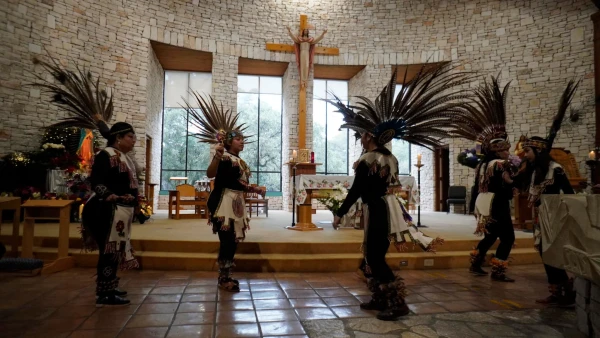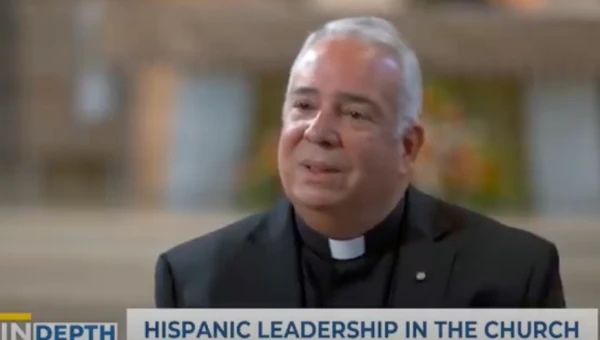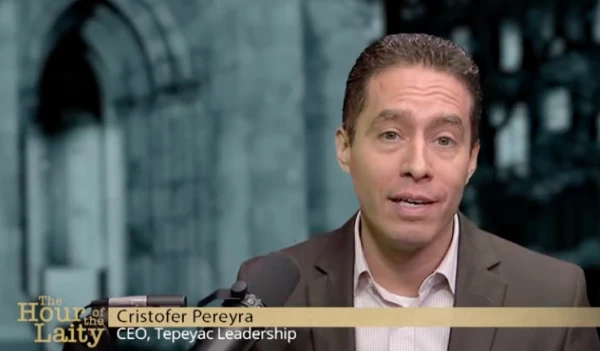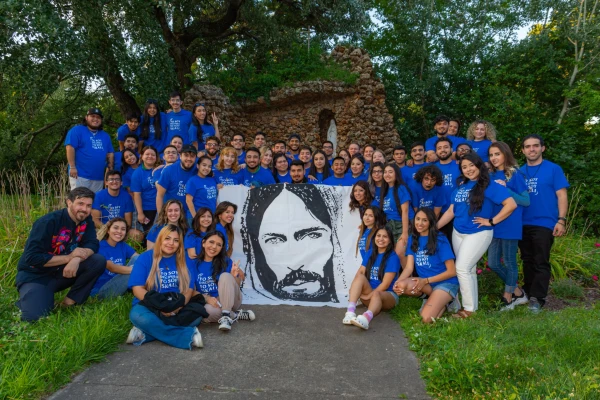Washington, D.C. Newsroom, Jul 15, 2024 / 06:00 am
It’s Dec. 12 in San Antonio. Despite the cold outside, the inside of San Fernando Cathedral is packed with thousands of people of all ages: young, old, and in between.
By the altar is a brightly lit image of Our Lady of Guadalupe surrounded by roses of all colors. It’s a peaceful scene.
But that peace is suddenly broken by the loud, quick thumping of drums and the rattling of maracas as two lines of brightly colored dancers process in from the back doors. In unison, the dancers approach the image of the Virgin and after dancing before Our Lady for a few moments, the drums cease just as suddenly as they began. All say a silent prayer and then the drums resume as the group exits the church.

This is the “danza de matachines,” a Mexican tradition practiced in parishes and cities across Mexico and the U.S. to honor the Blessed Mother’s feast day. The lively matachines performance will often be accompanied by special prayers, Mass, and parties that gather entire parish communities.
Since Our Lady of Guadalupe’s apparition in 1531, Catholicism has been a mainstay in the life and culture of Hispanics across Latin America and the United States.
But today the future of the Hispanic Catholic Church is being called into question as new reports and data indicate that Latinos, especially those under 30, are leaving the Church in significant numbers, leading some to ask: Is Catholicism dying out in the country's Hispanic communities?
Is the Catholic Church being replaced?
A recent study by the Pew Research Center found that 43% of Hispanics in America are Catholic, a major decline from 67% in 2010.
Some chalk up this trend to Hispanics converting to evangelicalism or other Protestant denominations. A recent article in The Free Press touted that narrative, claiming: “Latinos are flocking to evangelical Christianity.” But while The Free Press foresees an evangelical boom, available data as well as Hispanic leaders in the Catholic Church paint a different picture.
According to Pew, Christianity in the U.S. across all demographics has been waning. The Catholic decline among Latinos is being led by young Hispanics, ages 18–29, a demographic in which evangelicalism is also declining.
Today, 30% of Hispanics ages 18–29 identify as Catholic. Meanwhile, 11% of Hispanics in this age group identify as evangelical, 6% below the next two older age brackets, 30–49 and 50–64.
The largest religious group — 49% — of Hispanics ages 18–29 is religiously unaffiliated, a category often referred to as the “nones.” Thus, the average young Hispanic in America today is more likely to identify as a “none” than as either a Catholic or an evangelical.
“Young Hispanics are following the same trend as non-Hispanics,” said José Manuel De Urquidi, founder of the Juan Diego Network, a Latino media ministry. “By 25, most are leaving the Church. And contrary to what other people believe, they’re mostly going to the nones. Some are going to other Christian denominations, but most are not.”
Why are they leaving?
In an interview with CNA, De Urquidi explained that since the COVID lockdowns many Hispanics, especially younger Latinos, are neglecting to participate in basic aspects of the life of the Church such as Mass, confession, and other sacraments.
(Story continues below)
!["We're not doing enough to welcome young Hispanics, so they feel it is their abuelita’s [grandmother’s] Church or their parents' Church, but not theirs,” says José Manuel De Urquidi of the Juan Diego Network. Credit: "EWTN News in Depth:/Screenshot](https://www.catholicnewsagency.com/storage/image/deurquidi.jpg?w=600)
For De Urquidi and others who are deeply engaged in Hispanic ministry, it comes down to a crisis of communion and community. Oftentimes young people simply feel that they don’t belong in the pews.
“We’re not doing enough to welcome young Hispanics, so they feel it is their abuelita’s [grandmother’s] Church or their parents’ Church, but not theirs,” De Urquidi said.
Father Allen Deck, a professor of theology who also works in campus ministry at Los Angeles’ Loyola Marymount University, said that the trend among Hispanics is also “part of a much bigger phenomenon within a growing secular environment.”
“It’s not only about what is happening in the Hispanic-Latino context, but it’s what’s happening with institutional religions across the board,” he explained.
Though worrying, Deck said that the Church should use this as an opportunity to take young people’s concerns to heart, especially when it comes to their need for community and a sense of belonging.
“We need to be part of a living group of faith, whether that be family, parish, diocese, or society,” he explained. “So liturgical prayer that stresses active participation, particularly in the Eucharist, is very important for people to develop a sense of belonging to something bigger.”
What do America’s bishops have to say?
In 2021, the U.S. Conference of Catholic Bishops (USCCB) reported that the country’s Hispanic Catholic population, estimated at 30 million, comprises 40% of all U.S. Catholics.
Even dioceses in cities that are not traditionally associated with Hispanics are now seeing the fruits of the Latino Church.
“Faith is alive in the Hispanic communities,” Edmundo Reyes of the Archdiocese of Detroit told CNA.
“Yes, there are some challenges, especially among Latinos born in the United States, as part of the larger secularization of the American people,” he admitted. “However, faith is still a significant part of Latinos’ lives and worldview.”
Archbishop Nelson Perez of Philadelphia told CNA the country’s leading bishops understand the Church has been losing young Hispanics in significant numbers and is aware of the danger this reality poses.
Addressing the problem was the subject of extensive discussion at a national “encuentro” (encounter) organized by the USCCB in 2018. The event saw extensive discussions on how the Church can better minister to Hispanics and involved the input and participation of some 300,000 Latino Catholics from more than 3,000 parishes.
From these discussions, the country’s bishops drew up a National Pastoral Plan for Hispanic Ministry that was released in 2023. Titled “Missionary Disciples Going Forth With Joy,” the document outlines the bishops’ recommendations and priorities for U.S. dioceses, parishes, and Catholic institutions ministering to Hispanic Catholics.

Perez, who was lead bishop for the 2018 Encuentro, shared that one of the most powerful fruits of the initiative was that Hispanic lay leaders have begun to “take their place in the Church.”
This development, Perez believes, will be a boon to the Catholic Church in the U.S. “I find that Hispanics are very much within their comfort zones to reach out with their faith. Their faith is worn on their sleeve,” he said, adding: “Where Hispanic ministry is present it’s strong and vibrant.”
Pointing to his Philadelphia Archdiocese where he has seen previously emptying parishes now being filled with Hispanics, he concluded: “I don’t just think Hispanics are the future. They’re the present.”
Archbishop Gustavo García-Siller of San Antonio, who first came to the U.S. from Mexico in 1980, told CNA that despite the challenges and losses, “in many ways there has been change for the better” because the Hispanic population in the Catholic Church “has been more organized and has mobilized more and in that sense they’re more prepared for ministry in the Church.”
He believes that Hispanics, immigrants especially, will help bring new life into the Church.
“The newcomers nowadays, they bring with them their faith, which here we have been losing,” he said.
New life for the Church
Cristofer Pereyra, an immigrant from Peru who founded the Tepeyac Leadership Initiative, told CNA “the influence that Latinos have in the Church and society is only going to continue to increase.”

“Yes, we’re losing so many,” he granted. “But what I find is that the ones that stick around are more committed. They are very secure in who they are and in their faith.”
Though a painful process, Pereyra believes the result will be an even stronger Hispanic presence in the Church that will eventually lead to a resurgence of the faith.
“The ones who are staying are staying to lead, to lead within the Church and to lead outside,” he said.
Natalia Ramírez, a 23-year-old Hispanic Catholic who attends San Francisco de Asís Parish in Chicago and is a member of the Hispanic young adult ministry “Iskali,” put it simply: The Hispanic Church is facing a crisis because many Latinos were not taught the “beautiful gifts” of their Catholic faith.

Born in Mexico City and raised in a heavily Catholic Hispanic community in Chicago, Ramírez said that many of her family members and childhood friends no longer practice any faith at all.
But this doesn’t have to be the end of the story. She knows this from personal experience.
“The more I’m learning about the faith, the more I fall in love with it,” she said. “Before I had no idea of what the Holy Eucharist was. But after learning about the Holy Eucharist, I realized that Jesus is closer to me than I ever thought before.”






